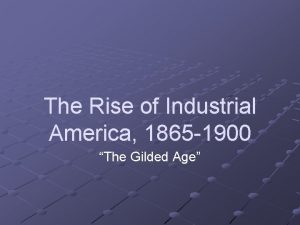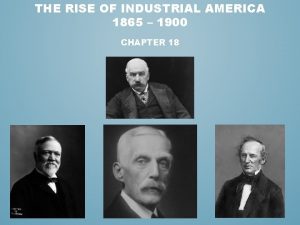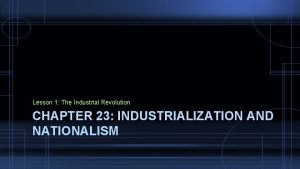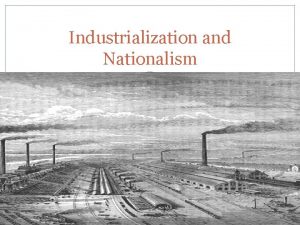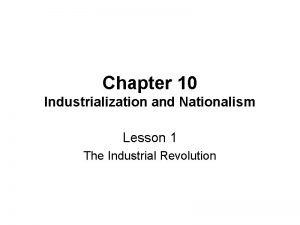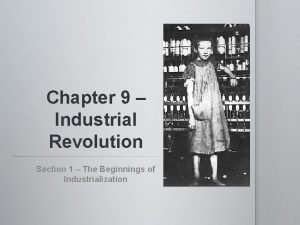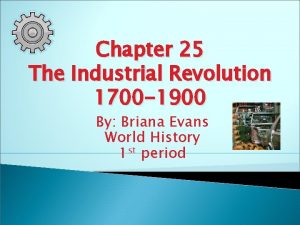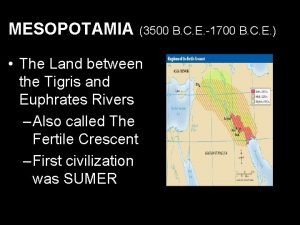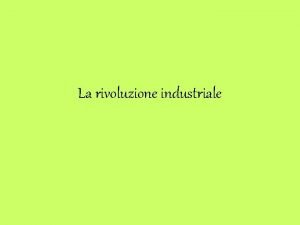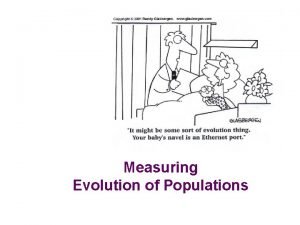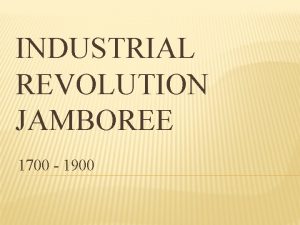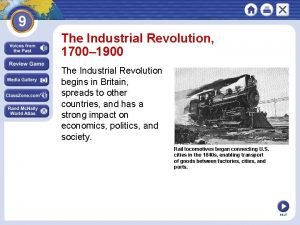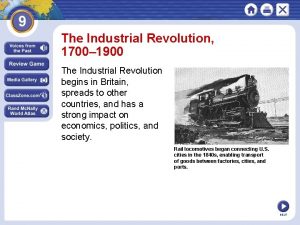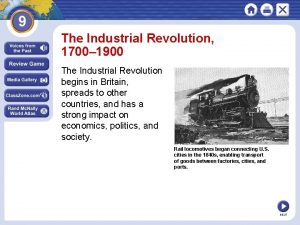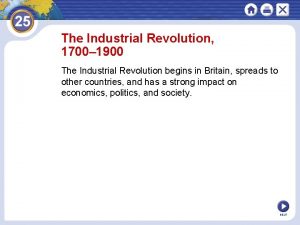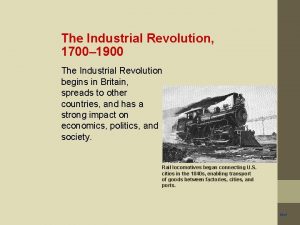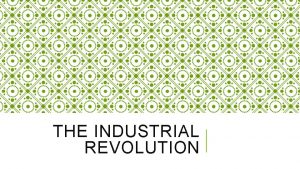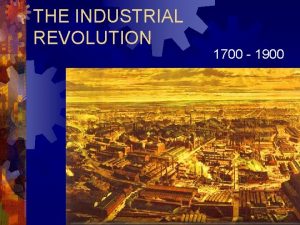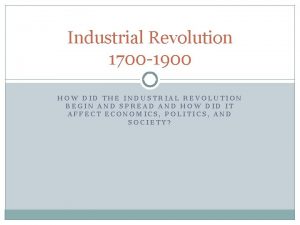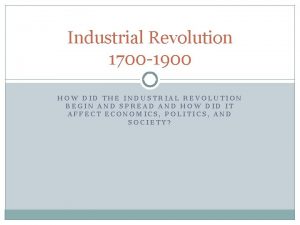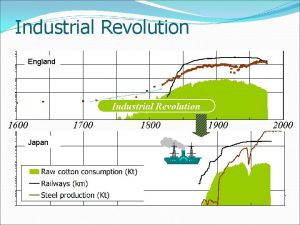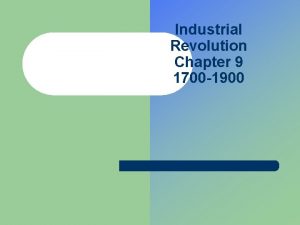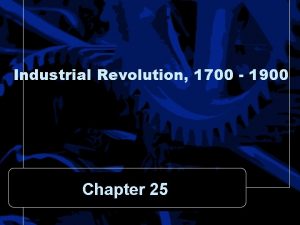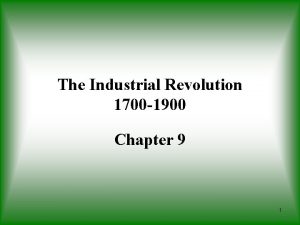The Industrial Revolution 1700 1900 CHAPTER 25 Chapter





















- Slides: 21

The Industrial Revolution, 1700– 1900 CHAPTER 25 Chapter Overview Time Line MAP GRAPH SECTION 1 The Beginnings of Industrialization SECTION 2 Patterns of Change: Industrialization SECTION 3 Industrialization Spreads SECTION 4 An Age of Reforms Visual Summary QUIT

CHAPTER 25 The Industrial Revolution, 1700– 1900 Chapter Overview During the 1800 s, Britain, the United States, and some European countries undergo a rapid process of industrialization. The Industrial Revolution creates great wealth but also great social and economic inequality, prompting a backlash of reform. HOME

CHAPTER 25 HOME The Industrial Revolution, 1700– 1900 Time Line 1701 Jethro Tull invents seed drill. 1793 Eli Whitney invents cotton gin. 1825 First railroad line built in England. 1875 British unions win right to strike. 1700 1900 1765 James Watt builds steam engine. 1807 Robert Fulton launches first steamboat. 1848 Marx and Engels publish Communist Manifesto.

1 HOME The Beginnings of Industrialization Key Idea In Britain, changes in agriculture lay the foundations for the Industrial Revolution. Other factors— including ample resources, an expanding economy, and political stability—provide the conditions for the rapid growth of industry. Overview Assessment

1 HOME The Beginnings of Industrialization TERMS & NAMES Overview • Industrial Revolution • enclosure MAIN IDEA WHY IT MATTERS NOW • crop rotation The Industrial Revolution started in England soon spread elsewhere. The changes that began in Britain paved the way for modern industrial societies. • industrialization • factors of production • factory • entrepreneur Assessment

1 HOME The Beginnings of Industrialization Section 1 Assessment 1. Look at the graphic to help organize your thoughts. List four natural resources needed for industrialization and how each resource is used. Natural Resource Use 1. Coal Fuel new machines 2. Iron ore Construct new machines, tools, buildings 3. Rivers Inland transportation 4. Good harbors Docking stations for merchant ships continued. . .

1 HOME The Beginnings of Industrialization Section 1 Assessment 2. What effect did entrepreneurs have upon the Industrial Revolution? THINK ABOUT • new technological developments • business opportunities • increase in prosperity ANSWER Possible Response: Entrepreneurs helped to promote the Industrial Revolution, because they were willing to risk their capital by investing it in new inventions and enterprises. End of Section 1

2 HOME Industrialization PATTERNS OF CHANGE CASE STUDY: Manchester MAP Key Idea Industrialization transforms British society: cities grow, work patterns change, and a middle class emerges. The city of Manchester becomes a notable example of the benefits and drawbacks of the new industrial age. Overview Assessment

2 HOME Industrialization PATTERNS OF CHANGE CASE STUDY: Manchester MAP TERMS & NAMES Overview • urbanization • middle class MAIN IDEA WHY IT MATTERS NOW The factory system changed the way people lived and worked, introducing a variety of problems. The difficult process of industrialization is being repeated in many lessdeveloped countries today. Assessment

2 HOME Industrialization PATTERNS OF CHANGE CASE STUDY: Manchester MAP Section 2 Assessment 1. Look at the graphic to help organize your thoughts. List the social classes in industrial England, and list the types of laborers and professionals included in each group. 1. Upper Class Landowners, aristocrats 2. Upper Middle Class Factory owners, merchants, government employees, doctors, lawyers, managers 3. Lower Middle Class Factory overseers, skilled workers 4. Working Class Workers in factories, mines continued. . .

2 HOME Industrialization PATTERNS OF CHANGE CASE STUDY: Manchester MAP Section 2 Assessment 2. How did industrialization contribute to city growth? THINK ABOUT • growth of industry • creation of jobs • the economic advantages of centralization ANSWER Possible Response: Industrialization promoted the growth of cities because the factory system led to manufacturing goods in a central location, and this, in turn, created jobs and economic opportunity. continued. . .

2 HOME Industrialization PATTERNS OF CHANGE CASE STUDY: Manchester MAP Section 2 Assessment 3. How might a factory owner have justified the harsh conditions in his factory? THINK ABOUT • class distinctions • the spread of factories • financial gains ANSWER Possible Responses: The factory owner might have believed that without jobs many of his workers would starve; that hard work is better than no work; all factories had the same conditions, so his were no worse; that if he were making money, that was all that mattered. End of Section 2

3 HOME Industrialization Spreads Key Idea Industrial technologies travel from Britain to America, causing an industrial boom in the United States. Industrialization also spreads to continental Europe and contributes to the rise of imperialism. Overview Assessment

3 HOME Industrialization Spreads TERMS & NAMES Overview MAIN IDEA WHY IT MATTERS NOW The industrialization that began in Great Britain spread to other parts of the world. The Industrial Revolution set the stage for the growth of modern cities. Assessment • corporation

3 HOME Industrialization Spreads Section 3 Assessment 1. Look at the graphic to help organize your thoughts. Give three examples of the effects of industrialization on the world. Widened gap between industrialized and nonindustrialized countries Strengthened economic ties between countries Worldwide Effects Promoted colonization continued. . .

3 HOME Industrialization Spreads Section 3 Assessment 2. Reread the quote by Lucy Larcom. Do you think her feelings about working in the mill are typical? Why or why not? THINK ABOUT • her experiences in a mill • her possible bias ANSWER Possible Responses: • Yes: She seems to be speaking as a young woman from New England who chose to work in the mill and was pleased with the experience. • No: Since she recorded her thoughts and experiences in a memoir or journal, she may have been more independent than most young women. End of Section 3

4 HOME An Age of Reforms GRAPH Key Idea Industrialization provokes positive and negative reactions in society. Some philosophers extol the virtues of free market capitalism, while others promote socialism, unionization, and a variety of reform movements designed to blunt the harsh effects of industrialism. Overview Assessment

4 HOME An Age of Reforms GRAPH TERMS & NAMES Overview • laissez faire • Adam Smith MAIN IDEA WHY IT MATTERS NOW • capitalism The Industrial Revolution led to economic, social, and political reforms. Many modern social welfare programs developed during this period. • utilitarianism • socialism • Karl Marx • communism • union • collective bargaining • strike Assessment

4 HOME An Age of Reforms GRAPH Section 4 Assessment 1. Look at the graphic to help organize your thoughts. Compare and contrast capitalism and Marxism. Capitalism Only Supported individual freedom; opposed government intervention; guided by profit motive; individual ownership of private property Both Economic arrangements central to society Marxism Only Factors of production owned by people; governmental control of factories, mines; predicted proletariat revolution continued. . .

4 HOME An Age of Reforms GRAPH Section 4 Assessment 2. What were the main problems faced by the unions during the 1800 s? How did the unions overcome these problems? THINK ABOUT • government restrictions • labor reforms • skilled workers vs. unskilled workers ANSWER Possible Responses: • Workers were denied the right to form unions; unions and strikes outlawed; unskilled workers did not have much bargaining power. • Unions fought back by getting their members to refuse to work; unions got Parliament to repeal the Combination Acts. continued. . .

4 HOME An Age of Reforms GRAPH Section 4 Assessment 3. According to Marx and Engels, economic forces alone dominate society. How important do you think such forces are? THINK ABOUT • other forces, like ethnic loyalties, desire for democracy • causes of the Industrial Revolution • the class structure ANSWER Possible Responses: • Economic forces dominate all areas of society. • Certain events are better explained by idealism and desire for freedom. End of Section 4
 The rise of industrial america 1865-1900
The rise of industrial america 1865-1900 The rise of industrial america 1865-1900
The rise of industrial america 1865-1900 Lesson 1 the industrial revolution
Lesson 1 the industrial revolution Industrialization and nationalism worksheet answers
Industrialization and nationalism worksheet answers Industrialization and nationalism lesson 1
Industrialization and nationalism lesson 1 The beginning of industrialization chapter 9 section 1
The beginning of industrialization chapter 9 section 1 Chapter 25 the industrial revolution
Chapter 25 the industrial revolution Marine corps request mast
Marine corps request mast Lexile calculator
Lexile calculator Nfpa 1700
Nfpa 1700 1700 piano
1700 piano 1700 ce
1700 ce 3500 + 1700
3500 + 1700 Eta 1700
Eta 1700 Rivoluzione agricola 1700
Rivoluzione agricola 1700 1700 luvun aatesuunta
1700 luvun aatesuunta Rotazione quadriennale rivoluzione industriale
Rotazione quadriennale rivoluzione industriale Jacobean and caroline prose
Jacobean and caroline prose To resize an embedded chart ____
To resize an embedded chart ____ 1 in 1700 us caucasian newborns have cystic fibrosis
1 in 1700 us caucasian newborns have cystic fibrosis Cisco aironet 2700 設定
Cisco aironet 2700 設定 1700 bce
1700 bce
